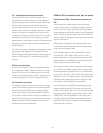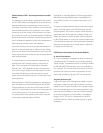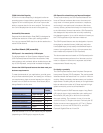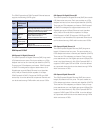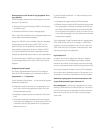OSA-Express Network Traffi c Analyzer is exclusive to the
z10 BC, z9 BC, z10 EC, and z9 EC, and is applicable
to the OSA-Express3 and OSA-Express2 features when
confi gured as CHPID type OSD (QDIO), and is supported
by z/OS.
Dynamic LAN idle for z/OS
Dynamic LAN idle is designed to reduce latency and
improve network performance by dynamically adjusting
the inbound blocking algorithm. When enabled, the z/OS
TCP/IP stack is designed to adjust the inbound blocking
algorithm to best match the application requirements.
For latency sensitive applications, the blocking algo-
rithm is modifi ed to be “latency sensitive.” For streaming
(throughput sensitive) applications, the blocking algorithm
is adjusted to maximize throughput. The z/OS TCP/IP stack
can dynamically detect the application requirements,
making the necessary adjustments to the blocking algo-
rithm. The monitoring of the application and the blocking
algorithm adjustments are made in real-time, dynamically
adjusting the application’s LAN performance.
System administrators can authorize the z/OS TCP/IP stack
to enable a dynamic setting, which was previously a static
setting. The z/OS TCP/IP stack is able to help determine
the best setting for the current running application, based
on system confi guration, inbound workload volume, CPU
utilization, and traffi c patterns.
Link aggregation for z/VM in Layer 2 mode
z/VM Virtual Switch-controlled (VSWITCH-controlled) link
aggregation (IEEE 802.3ad) allows you to dedicate an
OSA-Express2 (or OSA-Express3) port to the z/VM operat-
ing system when the port is participating in an aggregated
group when confi gured in Layer 2 mode. Link aggregation
(trunking) is designed to allow you to combine multiple
physical OSA-Express3 and OSA-Express2 ports (of the
same type for example 1GbE or 10GbE) into a single logi-
cal link for increased throughput and for nondisruptive
failover in the event that a port becomes unavailable.
• Aggregated link viewed as one logical trunk and con-
taining all of the Virtual LANs (VLANs) required by the
LAN segment
• Load balance communications across several links in a
trunk to prevent a single link from being overrun
• Link aggregation between a VSWITCH and the physical
network switch
• Point-to-point connections
• Up to eight OSA-Express3 or OSA-Express2 ports in one
aggregated link
• Ability to dynamically add/remove OSA ports for “on
demand” bandwidth
• Full-duplex mode (send and receive)
• Target links for aggregation must be of the same type
(for example, Gigabit Ethernet to Gigabit Ethernet)
The Open Systems Adapter/Support Facility (OSA/SF) will
provide status information on an OSA port – its “shared” or
“exclusive use” state. OSA/SF is an integrated component
of z/VM.
Link aggregation is exclusive to System z10 and System
z9, is applicable to the OSA-Express3 and OSA-Express2
features in Layer 2 mode when confi gured as CHPID type
OSD (QDIO), and is supported by z/VM 5.3 and later.
30



